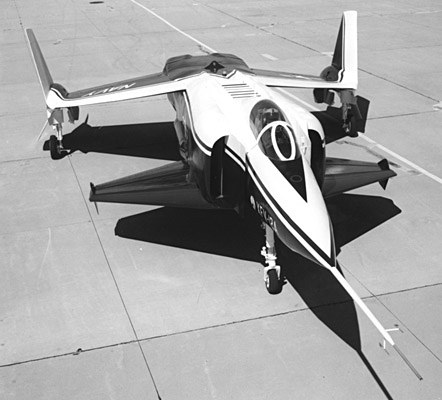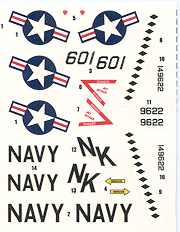
| KIT: | Anigrand Craftworks 1/72 Rockwell XFV-12A |
| KIT #: | aa-2026 |
| PRICE: | $49.50 MSRP |
| DECALS: | One option |
| REVIEWER: | Scott Van Aken |
| NOTES: | Short Run Resin kit with Vac canopy |

| HISTORY |
In the early 1970s there was a requirement put forth for the next generation VTOL fighter to replace the AV-8A Harrier that was then being developed for the RAF and USMC. The big difference was that this one was to be capable of supersonic speeds and operate from small ships. This meant a rather compact aircraft and new flying/lifting surfaces. A proof of technology aircraft was offered by Rockwell (formerly North American) that incorporated a 'thrust-augmented' wing.
This concept had the interest of the Navy and Rockwell was fully funded to provide one prototype, designated XFV-12. The aircraft was a mixture of bits and pieces from other planes as well as new sections. The nose was developed from an A-4, and the main fuselage from an F-4 Phantom, though it was a single engine aircraft. The use of a 30,000 lb thrust Pratt & Whitney F401 turbofan provided the needed power. Ducted air was run from the engine compressor stages to the tilting 'ejector flap' in the canard and main wings. This flap could rotate for vertical take off and then move to close the wing for normal flight. In 1978, the first hover rig test was undertaken without any success. Despite other attempts at redesigning the vertical lifting mechanisms, nothing seemed to work and in 1981 the Navy got tired of tossing money at it and cancelled the program without the aircraft ever achieving flight.
| THE KIT |
 If
you have read any of my other reviews of Anigrand kits, then you pretty
well know what to expect. This is a short run kit and as such isn't
perfect. Generally speaking, the parts are well molded with rather large
engraved panel lines. There are optional bits for hover mode and some of
the kit parts need to be cut to model this variation. No nose weight should
be needed as the wheelbase is quite long. The cockpit consists of a seat
and stick with no instrument panel. There is a single vacuformed canopy
that has rather indistinct panel lines. I do wish there was a second canopy
provided.
If
you have read any of my other reviews of Anigrand kits, then you pretty
well know what to expect. This is a short run kit and as such isn't
perfect. Generally speaking, the parts are well molded with rather large
engraved panel lines. There are optional bits for hover mode and some of
the kit parts need to be cut to model this variation. No nose weight should
be needed as the wheelbase is quite long. The cockpit consists of a seat
and stick with no instrument panel. There is a single vacuformed canopy
that has rather indistinct panel lines. I do wish there was a second canopy
provided.
 There
is a rather considerable amount of flash on some of the parts, but nothing
beyond the norm. I also
found that this one had more than its usual share of molding glitches with
both fuselage halves showing large holes. The leading edge of the wing is
also rife with air bubbles as you can see in the image to the right. I'll repeat that Anigrand really needs to
improve its quality control. Now
that I've gotten that out of the way, I'll say that while more extensive
than on most of their other kits, these kinds of things are pretty well the norm with many
short run, home shop companies. They offer products that few others will
tackle and to be able to model the subject we have to take the molding
problems that come with them. Fortunately, those of us who are experienced
with these kits will not have any real problems fixing the glitches as all
it
There
is a rather considerable amount of flash on some of the parts, but nothing
beyond the norm. I also
found that this one had more than its usual share of molding glitches with
both fuselage halves showing large holes. The leading edge of the wing is
also rife with air bubbles as you can see in the image to the right. I'll repeat that Anigrand really needs to
improve its quality control. Now
that I've gotten that out of the way, I'll say that while more extensive
than on most of their other kits, these kinds of things are pretty well the norm with many
short run, home shop companies. They offer products that few others will
tackle and to be able to model the subject we have to take the molding
problems that come with them. Fortunately, those of us who are experienced
with these kits will not have any real problems fixing the glitches as all
it  takes
is super glue or epoxy putty or a 'cut and replace' with strip styrene in
some of the more egregious areas.
takes
is super glue or epoxy putty or a 'cut and replace' with strip styrene in
some of the more egregious areas.
One thing I would consider replacing is the landing gear. This can be done with either plastic bits stolen from other kits or made out of tubing and wire. I've already had some warping problems with earlier kits due to the weight on the gear.If you have an old ESCI 1/72 A-4 laying about, it may be a good source of bits for this kit. As you can see from the image of the kit parts, there really are not that many bits and it is a pretty compact aircraft. The instructions are on the usual single sheet with one side containing a history and exploded view while the other has a three-view for painting and decal placement. There is also a very nicely done diagram showing the proper position of all the various flaps and panels if doing the model in the VTO mode. This one contains markings for a fictitious unit as shown on the mock-up (the box top picture) in Light Gull Grey and White. The actual aircraft spent most of its time in a very attractive blue and white scheme as shown in the photo. I'll probably scrounge something up from the spares to show an aircraft in use with an actual squadron. Anigrand's decals work fairly well though they are a bit thick and don't like compound curves.
| CONCLUSIONS |
Once again a really superb subject and a model that will definitely stand out from the rest of the crowd. I can only recommend these kits to those who are either experienced in dealing with the air bubble and other molding problems. Does that mean that you shouldn't buy this kit if it is your first one? Not at all. You have to learn how to build these and this would be as good a kit as any on which to test your skills.
Many thanks to DMC Models for the review kit.
UPDATE: Nostalgic Plastic is now the US Importer for Anigrand. Please contact them for more information.
December 2004
If you would like your product reviewed fairly and fairly quickly by a site that has nearly 300,000 visitors a month, please contact me or see other details in the Note to Contributors.